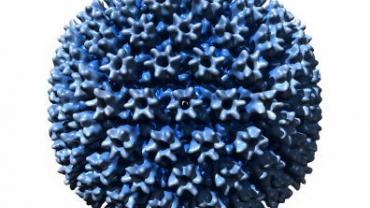
"
The cytomegalovirus (CMV) is a member of the herpes virus family which includes well known pathogens such as herpes simplex 1 and 2 varicella/zoster and Epstein's Barr viruses. Statistics show that between 50-80% of adults will contract CMV by the time they reach 40 years of age. While the large majority of those infected with the virus do not have symptoms that manifest those who are very young and/or have immune deficiencies may develop significant problems including increased morbidity and mortality.
Cytomegalovirus can affect the liver and spleen in newborns while also causing mononucleosis type symptoms enchpelitis and coma in immune deficient adults.
Since CMV is an unwelcome and permanent guest it demands a growing amount of attention from specific portions of the immune system. One particular mouse study showed that the longer mice were infected with CMV the more CD8+ T-cells were engaged with the virus leaving less to fight against other pathogens. Accordingly the immune system of mice infected with CMV did not respond well to other infections such as the flu and the West Nile virus.
CMV is one of a select number of virus types that can re-infect individuals who are already persistently infected by this virus. When most viruses infect a host the immune system remembers the disease and protects against re-infection. In the case of CMV the body's immune system is continuously stimulated by ongoing low level persistent infection yet CMV is still able to re-infect. The re-infection of CMV can only take place when the virus is able to evade CD8+ T cells. These white blood cells attack and kill infected cells as a part of the body's immune response. The T cells identify infected cells through the presence of MHC-I molecules on the outside of the cell wall. These MHC-I molecules present little snippets of viral proteins to the T cells that signal when a cell is infected. CMV evades this system by making genes that disrupt the ability of the MHC-I molecules to communicate the ongoing infection to the T cells. In other words CMV is able to cutoff an infected cell's call for elimination allowing CMV to overcome a critical immune barrier during re-infection.
Studies looking at the reactivation rate of CMV in individuals with apparently healthy immune systems have shown a reactivation of CMV in the bloodstream. In hospital patients the re-activation of the virus was associated with longer overall ICU and hospital stays.
Recent in vitro research suggests that several naturally occurring compounds provide activity against this ubiquitous virus and may be useful to individuals challenged by CMV.
Foods such as garlic contain several compounds that have been shown to be anti-microbial and specifically anti-viral. In the case of CMV garlic extract appears to help inhibit its replication.
The mineral zinc is an important nutrient in the T-cell activation cascade. Significantly lower levels of zinc were found in those women who tested positive for the virus while treatment with this mineral yielded positive results. These findings indicate that high blood serum levels of zinc were instrumental in fighting the virus.
Ginger extracts were also shown to inhibit not only replication of CMV but the herpes and HIV viruses as well.
Baicalein also known as Chinese skullcap is a traditional medical herb commonly used in Chinese medicine and possesses a great many health benefits and applications. Research has shown that it is also active against the virus.
News stories focusing on the next viral epidemic are always in our faces amping up society's already high level of fear. But the way to protect ourselves against these and other unseen microbes may very well be right under our noses.
by Michael Fuhrman D.C.